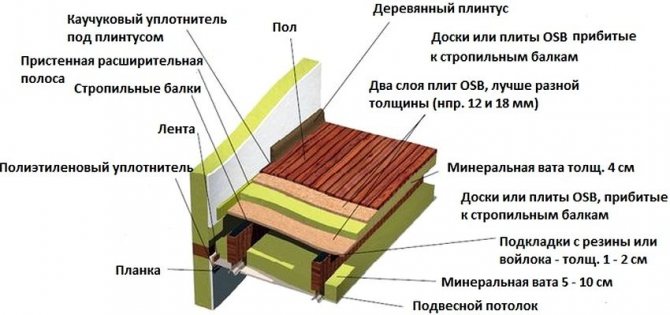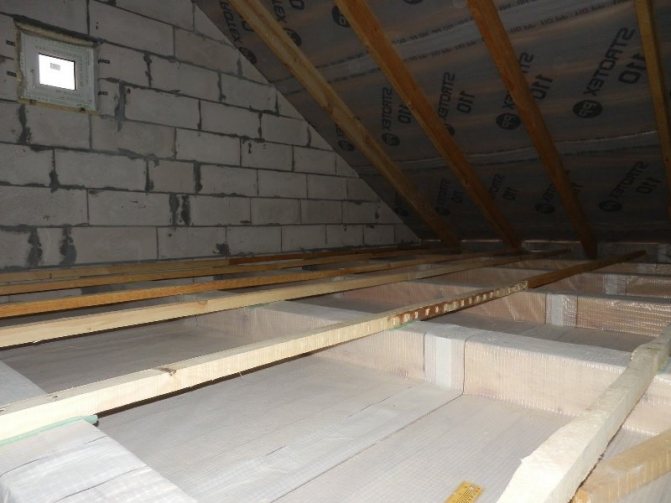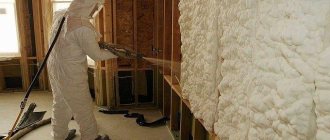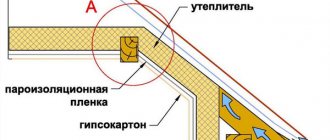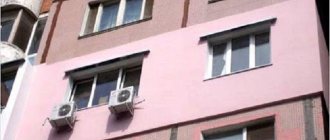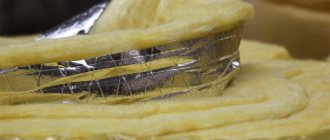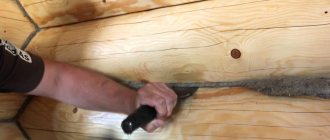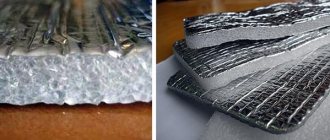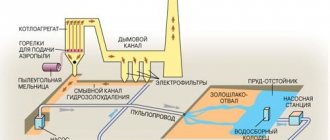The main types of insulation
Today, there are two optimal options: mineral wool (or glass wool) and foam. Each of these materials has its own positive and negative qualities.
Mineral wool is produced either in rolls or in sheets. The material has such positive aspects:
- the thermal conductivity index has a value of 0.041 W / (m ° C), this characteristic may vary depending on the density of the material itself, but such a change will be insignificant;
- good sound insulation, here just the density is of great importance;
- fire resistance: if a fire occurs, then in the absence of open fire, the material will quickly fade out;
- ease of fixing: the structure of mineral wool allows you to easily cope with uneven surfaces, and it also easily eliminates voids.
But this material also has disadvantages:
- poor moisture insulation: if such cotton wool gets wet, then the thermal insulation will worsen by 2 times;
- the installation technology itself has more complex features;
- rolls tend to roll, this factor is influenced by the dishonesty of contractors or improper independent insulation of walls from cinder blocks.
Polyfoam (extruded polystyrene foam), in contrast to the first option, is denser in structure, which makes it more durable. The moisture absorption rate is about 10 times lower than that of mineral wool. But all the qualities significantly affect the price of the material.
Polyfoam can be presented in the form of plates, less often in rolls. Of the positive aspects of such material, the following can be noted:
- good resistance to moisture: even if water gets on the surface, the walls will not lose their thermal insulation properties;
- applicable on flat areas, while covering them well;
- depending on the use of certain brands, it can have good fire resistance, therefore, like mineral wool, if there is no open fire near the hearth, this material will quickly fade out.
Among the negative aspects, the following characteristics should be highlighted:
- low level of noise insulation;
- some types of polystyrene absolutely do not tolerate fire, therefore, when insulating the walls of a house, you should carefully select a brand, otherwise during a fire it can emit corrosive smoke and support the fire itself;
- this material of the usual type has a rather fragile structure, which, in turn, leads to certain problems in installation.
There is an opinion that rodents like this material. But it is not so. Rodents do not eat polystyrene, but they equip their home in it, since it is warm enough.
Basic technical characteristics of blast furnace slag
When insulating, the main indicator is considered thermal conductivity... According to GOST and SNiPam, the thermal conductivity coefficient of crushed stone from blast-furnace slag is 0.21 W / (m ° C).
For comparison, let's take the thermal conductivity of medium hard mineral wool. It is 0.0326 W / (m ° C). This suggests that when insulating a building structure, a layer of crushed slag should be fatterthan a layer of mineral wool:
- Flakiness... The indicator characterizes the volume of smooth and angular elements in the filler. If the filler in a larger mass consists of smooth grains, then it reduces the percentage of adhesion of the material to each other, as well as to the binder solution. The indicator is applicable only for bulk materials, which are slag insulation.
- Strength - characterizes the level of pressure and mechanical stress, the maximum allowed on the filler. Slag insulation is stronger than mineral wool, foam. Due to their rigidity, they are not prey for rodents. In this, the insulation outperforms mineral wool, polystyrene foam, polyurethane foam.
- Frost resistance... The parameter characterizes the number of frost cycles that the filler can withstand without changing its technical characteristics and properties. According to GOST, modern heaters must have an indicator of at least F15 (i.e. 15 cycles). Manufacturers of any type of insulation adhere to this norm.
- Radioactivity - characterizes the class of radiation radiation. There are 3 classes, the 1st class is used in the construction of residential buildings, this applies to heaters of any kind.
- Density... This parameter shows what is the mass of the filler per unit volume. Slag insulation - heavy insulation. Their density is on average from 300 to 1000 kg / m3. This is several times higher than the density of other heaters.
For example, the density of mineral wool is on average 50-125 kg / m3. Thus, when insulating should be considered high density, and, accordingly, heavy weight of the slag.
Deserves special attention filler fraction characterization... The following levels are distinguished:
- 0 * 5mm;
- 3 * 8mm;
- 5 * 10mm;
- 5 * 20mm;
- 10 * 20 mm;
- 20 * 40mm;
- 25 * 60 mm;
- 40 * 70 mm.
It is recommended to use medium-sized slag as insulation. Very small and too large items not beneficial in thermal insulation.
How easy it is to insulate a cinder block house. Insulation of a cinder block house
Houses built from cinder blocks, unlike their wooden and brick counterparts, need additional insulation from the outside. The thermal conductivity of the cinder block varies between 0.35-0.6 W / (m 0C), which means that to ensure a normal temperature in the house in our harsh climate, it would be necessary to erect a building from cinder block slabs with a thickness of about 1.5- 2 meters, which is extremely unprofitable. That is why buildings made of cinder block slabs of standard thickness are additionally insulated from the outside.
To choose external or internal insulation? Professional builders recommend insulating a cinder block house from the outside, since after laying the heat-insulating layer inside the room, the dew point located between the coolant and the wall shifts. As a result, moisture will accumulate on the walls, contributing to the spread of moldy fungi.
Another disadvantage of internal insulation is that the heat-insulating material "steals" centimeters of the area of the room. That is why it is rational to insulate the cinder block house from the outside.
Features of a brick building
Many factors play a role in resolving this issue.
Brick parameters - hollow, solid, silicate, clay - each type of product is characterized by a certain indicator of thermal conductivity. The lower it is, the less thick insulation is required.
The nature of the masonry - solid does not have high thermal insulation properties, but, for example, a well, with an air pocket between two walls, in itself is a good heat insulator, and besides, it allows you to use in-wall insulation.
Climatic conditions - it is obvious that a brick house built in the northern latitudes needs more serious insulation than a building located on the shore of a warm sea. However, these works are necessary in all cases, and both the walls and the ceiling of the building should be insulated.
Thermal insulation technology for building structures
Heat engineering calculations and instrumental measurements show that 5-10% of the heat leaves the dwelling through the floor and soil, 20-30% through the walls and the same amount through the attic floors and the roof. Slag insulation can be used for these building structures.
The sequence of work to improve the thermal insulation characteristics for the floor, ceiling, walls is different.
Floor insulation
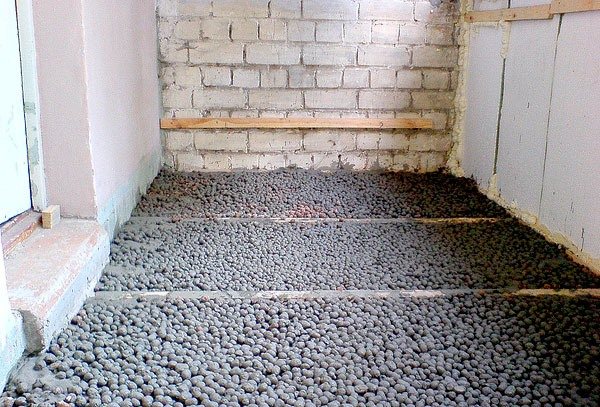
The slag layer is poured with a concrete screed
Depending on the design of the dwelling, floor insulation with slag in private houses is carried out in different ways. If, in the spring and after heavy rains, water appears in the basement, the basement must be waterproofed.
Brief instructions for warming an earthen floor:
- The surface is freed from debris, leveled, tamped if necessary.
- They equip the waterproofing, for which the floor is covered with clay, dissolved in water, and thoroughly mixed to a dough state. Another option: a layer of waterproofing roll material is spread, the joints are glued with mastic.
- A layer of insulation of the required size is carefully poured - the thicker the better. For most regions, it is enough to add 15 - 20 cm.
- Pour 5 cm of sand, ram.
- Pour a cement-sand screed (DSP) 5 - 10 cm.
If the height of the ceilings in the basement does not allow you to equip such a "cake", you can fill the floor with concrete, using slag as a filler. Before pouring, arrange a sand pillow, which is spilled with water and rammed.
The sequence of work is simple:
- They remove debris, dirt, dust.
- Cracks and technological holes are sealed with cement mortar.
- The stove is treated with an antiseptic to prevent mold and mildew.
- Cover the surface with a layer of vapor barrier film (membrane), which will prevent the penetration of vapors from the basement, but will allow moisture to evaporate into the underground room. In houses with dry basements, a vapor barrier is not required.
- DSP is performed on top of the heat insulator layer.
- After drying, they are finished with finishing materials (laminate, chipboard, linoleum).
Ceiling insulation
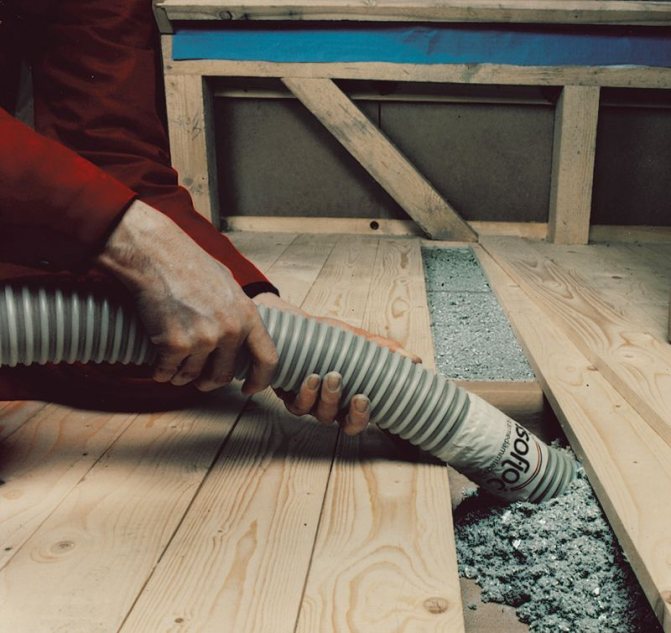

Insulation of the ceiling with slag from the attic
Technologically, the work on floor and ceiling insulation does not differ.
Before insulating the ceiling with slag, it is necessary to carry out calculations so as not to overload the structures. To do this, you need to find out the bearing capacity of the floor slabs and compare it with the mass of the backfill.
Slag as ceiling insulation has the same pros and cons as when used in other building structures.
The height of the non-residential attic allows you to pour a layer of any required thickness (taking into account the characteristics of the slabs). The insulation will retain its properties throughout the entire life of the house.
In order for the slag for ceiling insulation to retain its properties, precipitation should not fall on it. The dormer should not be closed tightly - this will help the moisture evaporate in a timely manner.
- Floor slabs are covered with a layer of waterproofing.
- The required amount of backfill is poured.
- Equip a concrete screed with a thickness of 10 - 15 cm, observing the slope for draining water during precipitation.
- Waterproofing is carried out with roll materials.
In order for the coating to last a long time, follow the instructions of the manufacturers of building materials.
Insulation of hollow walls
Insulation of walls with slag does not require special preparations. Any slag is poured between the outer and inner layers of the brick as the walls are being built. It is better to choose a porous material of the middle fraction. Such characteristics will make the house warmer, there will be no voids between the pieces of backfill.
Non-ferrous metallurgy slags in construction


Floor insulation scheme with slag.
Nickel and copper smelting slags are widely used in the construction industry. They do not disintegrate, the strength limit is 120-300 MPa. They are used for the production of mineral wool.
Blast furnace slags of the 1st grade have a coefficient indicating their quality - 1.65, for the 2nd grade - 1.45; grade 3 - 1.2. Slag crystal has become widespread.This material is used in construction for flooring, for cladding a building. When applied, the floors in private houses are of good quality, their service life is improved, and the costs required for thermal insulation are reduced.
Advantages and disadvantages
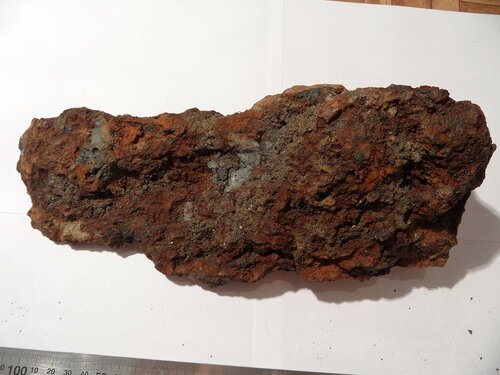

Metallurgical slag is not used in a humid environment due to its tendency to corrosion
Despite the difference in technical characteristics, all types of slags as insulation have similar positive qualities.
The material is different:
- ease of use;
- low cost;
- optimal air exchange;
- resistance to decay, fungus formation, mold spread;
- the ability to use in any premises;
- mechanical strength and chemical neutrality;
- inaccessibility to damage by rodents and insects;
- good indicators of thermal conductivity compared to monolithic concrete or brick;
- unlimited use time, subject to installation technology;
- fire safety.
The structure of the material imposes restrictions on the application. The high specific gravity is taken into account when designing load-bearing structures.
Slags are less effective relative to modern specialized products for thermal insulation - polystyrene, foam insulation, mineral plates, etc.
Metallurgical type is susceptible to rust in high humidity conditions.
Industrial types of insulation are hidden with a screed or filled into the voids of the brickwork to prevent the ingress of harmful substances into the air of residential premises.
Types of material
The following types of insulation are obtained from the waste of metallurgical production and the energy industry:
- domain;
- metallurgical;
- fuel and coal.
Different types are used to insulate the structural elements of the house.
Domain
The material is obtained by smelting pig iron. The composition includes the remains of rocks, fluxes and fuel ash. The pieces are very porous, the material is free flowing.
In private construction, the small (heavier) fraction is used for filling cavities in the walls or for screed concrete floors. The coarse fraction - light in weight - is suitable for filling attic floors.
This type of raw material is used for the manufacture of slag insulation materials.
Slag pumice, which has good heat and sound insulating properties, is most suitable for insulation. She also goes to the filler for cinder blocks.
Metallurgical
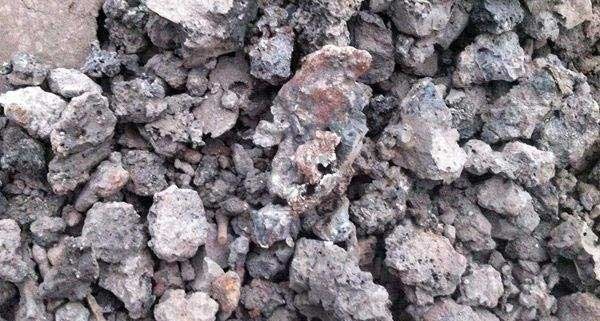

Metallurgical slag can overload the foundation
This type often includes waste from nickel and copper smelters, steel plants.
The material consists of sintered pieces of various fractions. They contain a lot of metal oxides, which is why the mass of the composition is large.
Fuel
The raw materials for the production are the remains of fuel oil and coal burned in boiler houses. Fraction and properties depend on the type of combustion (chamber or layer).
Fuel residues are hygroscopic, therefore, before backfilling, they must be dried for at least 2 months without exposure to precipitation.
It is used for filling cavities in brick walls or under a concrete screed on floors and ceilings.
Slag varieties
Roof insulation with slag can be performed using one of the following types of this material:
- fuel;
- coal;
- metallurgical;
- domain.
Fuel
Fuel slag is a free-flowing material based on loose silicate masses. It is obtained by burning coal in the form of fractions or dust in a layered or chamber method. The first type of slag has an inhomogeneous structure, and the second has a finely porous homogeneous structure.
The ash content per unit volume can reach 40%, which indicates the relatively low strength of the material. In addition, unburned fuel residues may be present in its composition, which impair the thermal insulation properties.


Fuel slag
Fuel slag is porous, therefore it is able to accumulate moisture, which requires the use of high-quality waterproofing during installation.
The main advantages of this type of slag are:
- high level of sound insulation;
- the possibility of obtaining a flat base for laying the floor covering.
Coal
Coal slag is formed as a result of burning coal and the occurrence of high-temperature reactions with inorganic components that make up its composition. Differs in high strength, since the ash content is up to 4%. The amount of unburned fuel is up to 20%, depending on the combustion method and chemical composition.
The features of coal slag are:
- volume fraction of the crystalline phase up to 80%;
- types of oxides in granules: aluminum, silicon, calcium;
- in terms of chemical composition, they are super acidic, basic and acidic.
Metallurgical
Metallurgical slags are obtained by melting nickel and copper compositions. They do not disintegrate, are not susceptible to rusting, and have a high tensile strength - up to 300 MPa. Their main application is fibers for mineral wool.
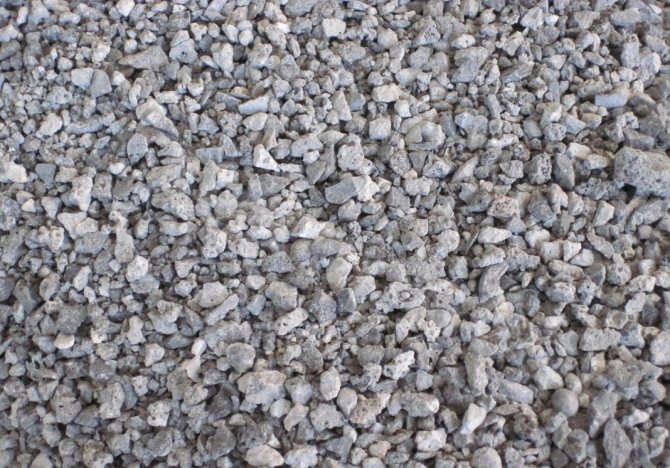

Metallurgical slag
They are resistant to chemical influences, sound insulating properties, low porosity and moisture absorption.
Domain
Blast furnace slag is a by-product of smelting pig iron from iron-bearing ores in blast furnaces. When melted, it floats above the cast iron, which simplifies its separation from the bulk. Properties depend on the composition of the ore, the fuel used, the smelting process and the cooling rate.
How to insulate cinder block walls from the inside
The steam room in the bath is insulated from the inside.
Internal insulation of a house from a cinder block is not welcome, except that as additional thermal insulation, for example, you can use a special paint with ceramic hollow spheres or penofol. They are ineffective as independent materials. Thermal insulation of cinder block walls from the inside is practiced in a steam sauna, when it is additionally necessary to protect the walls from moisture. In this case, the main thing is not to allow moisture from the steam room to get into the insulation layer. Naturally, only mineral wool can be used. Method of work:
- a wooden frame is erected on the inside of the walls in the steam room;
- mineral wool, preferably basalt, is laid between the guides;
- foil insulation is spread over the lathing - it is very effective for saunas, as it upholsters infrared radiation and does not let steam through;
- the second tier of the crate is installed on top of the penofol;
- a wooden lining is attached to the second tier.
Minvata must be laid in two layers and make sure that the joints do not coincide. The minimum layer of insulation is 10 cm. The main thing is not to forget to glue the joints of the penofol with a special (not clerical) tape. Also, you can not neglect the ventilation gap between the penofol and the wooden clapboard. Without it, reflective insulation simply will not work, besides, the condensation on the foam must evaporate. Penofol foil often contains small holes that are invisible to the eye. Therefore, to play it safe, you need to lay a vapor barrier membrane under the penofol.
How to insulate the ceiling
When choosing the appropriate material, the main issues are the presence or absence of an attic and the parameters of a heat insulator. The nature of the future ceiling is also important - suspended, tensioned, made of plasterboard, and the like. External insulation - used in private brick houses with an attic. In this case, thermal insulation can be made from the floor of the attic space and thereby maintain the height of the living rooms. As a rule, this method of insulating a building is cheaper, since it allows the use of bulk materials, the cost of which is much lower.Installation is also much easier, since all work is carried out on the floor.


The principle of action is simple: if the floor is concrete, then wooden logs are laid on it, if the base ceiling is beamed, then the space between the beams can be used. The first layer is a waterproofing agent - glassine, izolon or even roofing material, and then a heater is very tightly placed between the lags - polystyrene foam, polystyrene foam, mineral wool. Then a plank floor is laid on top. Expanded clay or even clay with sawdust can be used as a heat insulator. In the photo - bulk insulation in the attic.
Internal - if there is no attic, the ceiling should be insulated from the inside. The surface is glued with glassine, and plates of mineral wool or penoplex are fixed on top. The plates are installed in a spacer, the foam is glued, and the mineral wool is fixed with dowels. It is recommended to install another layer of vapor barrier. and then decide how to make a finishing ceiling surface.
If the base floor is a beam, then the heat insulator is placed between the beams, if it is concrete, it is necessary to make a crate. The material of the latter depends on the nature of the finishing coating: for wooden lining, plywood, OSB boards, it is recommended to build a wooden crate. For plastic finishing or plasterboard structures - metal.
What are the materials for insulation
There are a lot of materials. They are distinguished from each other by some important criteria. These include:
- Thermal conductivity. The best thermal insulation is possessed by a material with a lower index.
- Moisture resistance. The more insulation tends to gain moisture, the better waterproofing needs to be done.
- Flammability. It is advisable to choose a material that will not be flammable.
- Durability. Some isolates tend to wear out quickly and become unusable under certain conditions. This should be taken into account when choosing it.
- Environmental friendliness.
When answering the question, the better to insulate the ceiling, you can consider the following options:
- mineral, basalt, glass or ecological wool;
- foam or extruded polystyrene foam;
- expanded clay;
- PPU or penoizol;
- shavings or sawdust;
- tree leaves (usually oak) and straw.
Sometimes in the baths, the ceiling is insulated with earth or sand. However, this is quite rare. Leaves and straw are not used very often. It is an ecological material that is not durable and moisture resistant. Therefore, for its installation, it is necessary to know and strictly follow the technology.
Another important criterion is applied to the ceiling insulation - light weight. Thermal insulation should not weigh down the floor structure. In this regard, earth and sand are used rarely and more often for non-residential premises.
Let's consider each material in more detail.
General recommendations
It is possible to insulate floors both during the construction phase and in a residential building. But before you start working, you need to clearly formulate the goal. This will allow you to determine the required level of thermal insulation and select the right materials. For example, if the attic has already been insulated, it is enough just to put a new one on the old layer of insulation.
If the attic is planned to be used as an attic, then the thermal insulation should consist of three layers: vapor barrier (laid with the rough side down, smooth - towards the thermal insulation), thermal insulation layer and waterproofing
It is extremely important to do this, because the residential part of the house is located under the ceiling, and the warm air rising to the floors contains so much steam that it can easily ruin any thermal insulation
Before starting work on insulation, it is necessary to check the condition of the roof, as well as the beams, if we are talking about wooden floors. They must be protected from moisture using a special compound.
It will be a mistake not to leave gaps in the thermal insulation layer.They will be needed to provide the necessary ventilation of the room and to prevent the formation of condensation or moisture accumulation under the roof.
In addition, all work must be carried out in dry weather, and even better - in the warm season.
Wall insulation with expanded polystyrene
Styrofoam installation is carried out in almost the same way as the installation of mineral wool.
The first stage is surface preparation. Elimination of defects and application of a primer. Further, after preparing the adhesive solution, we proceed to the installation of insulation sheets.
Important: there should be no gaps or gaps between the plates!
After laying the insulation boards on top of them, you need to fix the reinforcing mesh. Further, this whole cake is carefully primed and putty, after which you can proceed to the final stage - applying a decorative coating.
When the house is insulated from the inside, the internal space of the room is significantly reduced. Nevertheless, this fact is not critical in order to completely abandon the insulation and in the cold season suffer from low temperatures outside the window or throw financial resources into the chimney to heat the house.
Before answering the question of how to properly insulate a house from a cinder block from the inside, you need to deal with the materials offered by construction stores. Today the market offers insulation based on foam and mineral wool. Editing both one and the other does not require any specific skills from the performer.
We insulate the cinder block house with polystyrene foam
The complexity of the installation of this material lies in the preliminary alignment of the walls on which they will be glued. In the case of a brick wall, plastering and puttying will be required. Without fail, wallpaper must be removed from the walls and paint residues must be removed.
Every owner of an apartment or house undoubtedly has a dominant desire to preserve the final result for the longest possible time. That is why the use of a waterproofing substrate, even inside the house, should be indispensable. For what? In order to thus prevent the accumulation of condensate that degrades the foam.
For work you will need:
- five centimeter foam;
- comb or notched trowel;
- glue (usually Ceresit).
Installation work is extremely simple. On the prepared wall, with the help of diluted glue, insulation plates purchased from a building materials store are attached. Then they are thoroughly tapped to remove possible air bubbles from under them. In this matter, an important point is to apply the adhesive mixture directly to the wall and in no case to the foam sheets themselves. They must always be dry.
Further, for optimal insulation of the house, all cracks and loose fit of the material should be treated with polyurethane foam. This must be done in order to isolate the glued layer from changes in humidity in the room.
In the process of fixing foam plates, you can also use special fixing dowels. However, the adhesive solution will suffice. The final step will be the front finishing of the walls and their possible painting.
A fairly quick and practical way. Its most important advantage is the elimination of the pre-leveling stage of the walls. The thing is that mineral wool slabs are installed in a specially created metal structure. Then, in stages, the entire frame is sewn up with plasterboard plates, which will give your wall a perfectly flat surface.
So, a special structure is assembled from metal or wooden profiles - lathing. Plasterboard plates are installed on it. Next, the joints are putty and the wall is either painted or wallpaper is applied to it.
Insulation of ceilings from the inside
Such thermal insulation can become relevant in the following situations:
- the presence of a residential attic;
- a house with several owners;
- engineering communications in the attic.
And this is only part of the circumstances that can be faced in practice. Bulk varieties are not suitable in this case, for obvious reasons.
Most of all they prefer such solutions:
- leafy;
- roll;
- sprayed.
The best option in most situations is expanded polystyrene plates, pressed mineral wool. Such products are in a leading position in terms of speed of work, the ratio between price and quality.
If the budget is not limited, it is allowed to stop at Penoizol. Any buyer will figure out how to properly insulate the ceiling in a wooden house using this material.
Foam insulation
The material is the second most popular, next to mineral wool. This name was given by a whole group of mineral materials. Their structure includes cells filled with gas. Expanded polystyrene with polyurethane foam are most widely used in practice. 0.041 W / (mK) - thermal conductivity retained for materials.
Low prices and light weight are the main advantages of foam plastics. But there are also disadvantages:
- Indoor greenhouse effect.
- For insects and fungus, foam will not become a breeding ground, but mice may appear inside the material.
- The release of a large amount of harmful substances, the maintenance of combustion.
Typically, the cost of work is from 400 to 2000 rubles, depending on the specific situation. Such indicators also influence the decision on how to insulate the ceiling in a wooden house.
Stages of work
Polyfoam can be mounted on a frame or glue. The first method works in the same way as with ordinary mineral wool. The difference is the use of liquid nails when the styrofoam sheets are laid on the sides.
The step-by-step instructions look like this:
- The surface is thoroughly cleaned. Be sure to get rid of any irregularities present. The primer is used if necessary.
- The foam sheets are covered with glue. It is recommended to use its tiled version. You have to wait about three minutes before the sheet is pressed against the surface of ceilings or attics.
- The same procedure is maintained for the rest of the sheets.
- The next layer is reinforcing plaster, fiberglass mesh laying. When everything is dry, apply another layer of plaster.
Ecowool
The eco prefix in the name of the material is used not only to attract attention. This product is truly environmentally friendly. After all, 80% of the composition is cellulose, of natural origin. The rest includes various additives that protect against negative environmental influences or change characteristics for the better.
Fire retardants in the composition make it so that combustion is not supported for a long time. 0.038 W / (mK) - thermal conductivity index.
Stages of work
In this case, installation also involves the use of one of two options. These are the so-called "dry" and "wet" options. The first case involves laying ecowool in special "cells" of the ceiling, prepared in advance. But then the thermal insulation properties will be only 80-90 percent of the total.
In the second method, ecowool is moistened with special equipment. Then spraying is carried out under high pressure. The insulation of the ceiling of a wooden house becomes sticky when it comes into contact with water. The disadvantage is that this particular method of installation requires additional costs, assistants are often invited.
Mineral wool
Fiber-type ceiling heat insulator. It is produced in roll or plate form.
Mineral wool is produced in three varieties, according to GOST:
- stone;
- slag;
- glass.
Due to its low weight, the mineral wool is convenient not only during installation, but also during transportation, storage under any conditions.This is a non-flammable base.
An additional advantage is complete protection against the development of harmful microorganisms and various insects and other types of pests. This is important for those who are interested in how to insulate the ceiling in a wooden house.
Stages of work
It also has its own step-by-step instructions.
Compliance with her recommendations helps to achieve goals with minimal losses:
- A vapor barrier film is laid on the floor of the attic. The main thing is that there should be no gaps on the base. Special vapor barrier tape is used for gluing seams. We insulate the ceiling in wooden houses further.
- At the top, the lathing is installed with a base made of galvanized profile or wood. The insulation will be denser if the distance between the components is only a few centimeters. The height of the lathing should be 1-2 centimeters higher than the vapor barrier layer. Then the interlayer air circulation is easier to equip.
- Mineral wool is unpacked and placed on the crate. If there are several layers, the subsequent ones should overlap the previous ones.
- The waterproofing is attached to the very last layer. To do this, you can use a special furniture stapler. The main thing is not to forget that at least a small free space should remain between the elements in order to ensure air circulation after insulating a wooden ceiling in a private house.
Insulation of the ceiling with underfloor heating
In this case, various modern materials are also used. Some of them are the same as those already described above. The main advantage is that the heat will spread throughout the entire area.
Stages of work
The order of the project implementation depends on what kind of composition is used in a particular case. It is better to study the recommendations from the manufacturers in advance. Or talk to other buyers who already have experience in a particular job. And who use warm ceilings in a wooden house.
Warming with expanded polystyrene
Most often, thermal insulation is made with a sheet of polystyrene or polystyrene foam. These are the most common polystyrene foam insulation materials. In terms of thermal conductivity, it is on a par with mineral wool. However, unlike her, it does not have high moisture resistance and is harmless to humans. Therefore, insulation of the ceiling with penoplex or polystyrene is often done from the side of the residential part of the room. The use of any of the materials will allow you to achieve a balance in the ratio of price and quality.
Like any other insulation, this one needs hydro and vapor barrier so that condensation does not form. After all, moisture destroys the ceiling. As such isolation, it is permissible to use:
- isospana;
- penofol;
- special films and membranes;
- penetrating mixtures and other things.
Despite the fact that sometimes the ceiling is insulated with penofol, it is sometimes used for waterproofing. Thermal insulation is carried out with penofol from the inside of the room. Since it has one foil side, this will reflect heat into the interior of the rooms.
Since foam is cheaper than foam, it is often used to insulate an apartment building, in a cellar to insulate walls, in apartments on the floors and walls outside, on the attic floor of private houses. This material is perfect if you are thinking about how to insulate the ceiling in your country house. Residents of apartment buildings rarely install thermal insulation on the ceilings. Since the apartments are located one above the other, heat loss occurs only through the outer walls. Styrofoam is placed on concrete floors so that the cold does not pass from below. This is mainly done by the owners of the lower floors, where the ground transfers cold in winter. In this regard, the ceiling in the apartment on the top floor is insulated, since it is not possible and advisable to put the material on the walls of the attic from the inside with your own hands.
Cellar insulation with foam can be carried out from the inside.This is especially true when the cellar is a basement. However, you should be careful, because there is a high probability that condensation will appear. The use of hydro and vapor barrier will correct this drawback. A kind of cake is made: inside it are expanded polystyrene plates, and layers of insulation along the edges of the sheet.
Recommendations for insulating a house with slag
In order to insulate the floor and ceiling with slag to ensure a comfortable stay in the room at any time of the year, it is recommended to adhere to the following recommendations during the work:
- the height of the insulating layer depends on the load that will be applied to the floor and ceiling,
- before applying the screed, in order to increase the mechanical strength, the floor can be equipped with a reinforcement,
- the floor and ceiling from the attic side can only be used after the concrete layer has completely hardened.
https://www.youtube.com/watch?v=WX-txHbYx7A
Thus, insulation of the floor and ceiling with slag in a country house or city apartment is much easier than it might seem at first glance. To do this, it is enough to follow the instructions and perform all stages of work with high quality.

